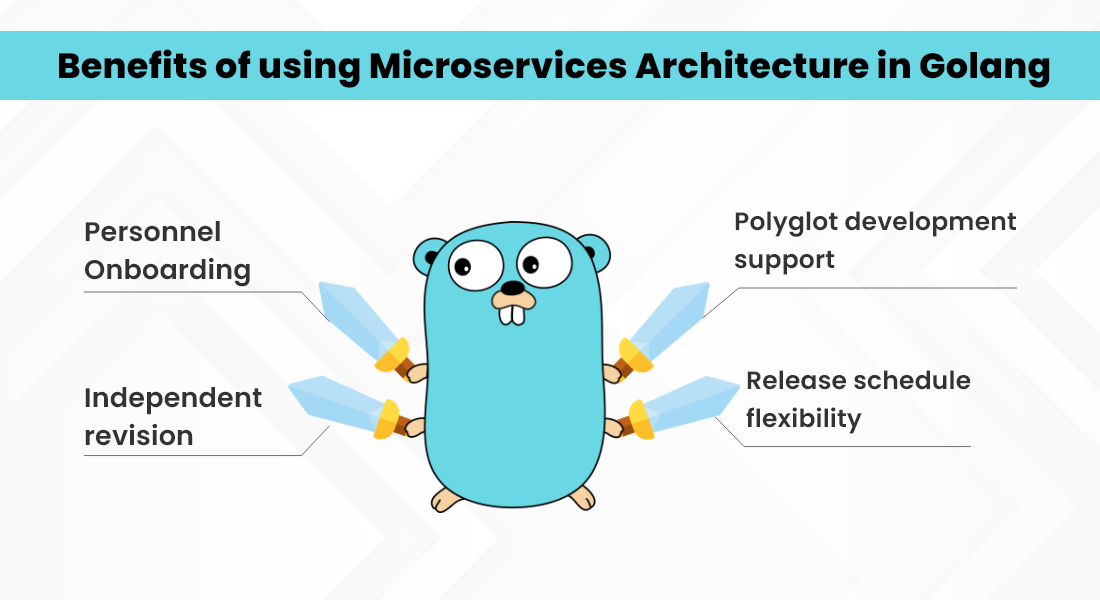Quick Summary:
The term “Microservice Architecture” has been in talks for quite some time now. It is the hot new gossip in software architecture. So why should we use Golang Microservices Architecture? And what are the pros? So in this blog, we will cover the related questions. So without much further ado, let’s start.
Table of Contents
Why Golang Microservices Architecture?
This setup of architecture helps us picture the entire application in parts or in small modules, which makes it easier to understand, develop, and test. It helps us in seeing the services as separated yet clearly specifies the use of it in the application.
On top of that, it helps in making the project more immune to architectural erosion (It is referred to as the difference between the planned architecture and the final architecture after the development is complete).
It helps in parallelizing the development by creating different independent teams to deploy and scale the services assigned to them. It is easier to refactor the code in this architecture. And it enables the continuous flow of delivery and deployment.
Advantages of Golang for Microservices Architecture
Here are some of the prominent advantages of using Microservice architecture Golang:
1. Personnel Onboarding
New developers added to the project can straightaway begin with the microservice development because they are standalone and encapsulated. Eventually, they get to know the complete architecture.
2. Independent Revision
Every microservice is independent of other microservices; it is encapsulated. Hence, you can modify and update every microservice per your requirement and revise independently.
3. Polyglot Development Support
developers can build every microservice using different development tools because it wouldn’t affect the development of other microservices. Similarly, every microservice can have varied database storage.
4. Release Schedule Flexibility
Being independent of each other, microservices can have varied release dates. Thus, they are not bound and have flexible release schedules.

Building Microservices with Golang
Building microservices using Golang is quite famous for developing modern and scalable applications. Following are the ways to build microservices with Golang:
1. Decomposing Applications Into Microservices
Decomposing applications into microservices means breaking down services into smaller and independent services. It helps to deploy faster and manage services separately. Also, Golang’s simplicity, powerful library, and syntax make it easy to build microservices.
It can handle high traffic loads and remains highly available in the environment. The standard library makes building microservices execution speed with dynamic concurrency capabilities.
2. API Gateway and Service Discovery
You can use API gateway and service discovery to manage communication among the microservices. Golang’s standard library provides numerous packages for handling HTTP requests, such as the “net/http” package.
Service discovery utilizes to locate the IP address and port of specific microservices instances. There are various third-party tools for service discovery, including Consul.
3. Implementing Microservices Using REST, gRPC or GraphQL
You have various options to implement microservices; gRPC, GraphQL, and REST are the best options. GrPC is a new and efficient protocol used for binary data in communication and is highly suitable for concurrent microservices.
REST is a famous API for easy use and simplicity. Also, Golang’s standard library provides numerous packages for building RESTful APIs, like Net/HTTP. GraphQL is a dynamic and robust protocol that allows you to specify what data they need from microservices and decrease network traffic by enhancing its performance.
4. Handling Data Persistence and Messaging
Data persistence and messaging and messaging are critical components of Golang microservices architecture. The data persistence includes managing data separately for each microservices.
While messaging allows microservices to communicate asynchronously and decouple from each other, Golang provides numerous packages to work with multiple databases, such as Databases/Sqi, for flexible and powerful interfaces to manage databases.
5. Deploying Microservices Using Docker and Kubernetes
Docker and Kubernetes have commonly used tools for deploying and managing Golang microservices frameworks. Docker is a containerization platform that allows you to package your microservices and their dependencies into a single, portable container that can be run on any system.
Kubernetes is a container orchestration platform that provides a robust system to manage and scalable applications, making it easier to deploy. Also, it helps to manage microservices in a production environment consistently and repeatedly.
Does your next Go application need microservices?
Hire Golang developer from us to build a performant Golang application to match your business needs.
Best Practices for Golang Microservices Architecture
Following these best practices for Golang microservices architecture, you can design scalable, secure, and resilient applications that adapt to changes.
1. Focused on Small Microservices
You can build scalable apps by breaking down a monolithic architecture into smaller, independent components. Each service should focus more on microservices; it must be tested and deployed to make managing applications more manageable.
The microservices are easier to understand and maintain, which boosts productivity and decreases the risk of bugs. Additionally, you can build modular and flexible applications efficiently by focusing on small microservices.
2. Automate Testing and Deployment
Several parts of microservices require to be tested and deployed, but by adopting automation, you can fasten up the process and reduce the risk of human error. Additionally, you can increase the reliability of the applications.
Also, automated testing helps to catch the issues in the initial development stage and, with the automation deployed, ensures that changes are run smoothly and securely. In addition, you can adopt new features and Continuous integration and continuous delivery (CI/CD) pipelines to enhance applications.
3. Secure Data and Communication
One of the best practices you can adopt in Golang microservices architecture is to secure data and communication, as in distributed system, security is essential. Golang microservices help improve security by allowing services to design with the protocol.
Also, ensure that each service is responsible for its security, including encryption, authentication, and authorization. With security in mind, you create applications resistant to cyber-attacks and data breaches.
4. Monitor and Implement Versions
In a microservices architecture, services are constantly changing and evolving. Thus, monitoring and implementing updated versions for better outcomes is crucial. You should monitor service performance, availability, and various changes to manage effectively.
Also, ensure that changes are controlled and tracked so any issues will be identified early, and you can improve the application with immediate change. Additionally, each microservices ensures compatibility and avoid breaking changes. Metrics are helpful in monitoring system behavior and are used to manage changes.
5. Use Asynchronous Communication
Using asynchronous communications helps improve the microservices architecture’s scalability and performance. By utilizing asynchronous messaging patterns, services can communicate without waiting for a response.
The event-driven architectures help to decouple microservices, allowing them to run independently and asynchronously. Also, it helps to enhance system scalability and resilience, which lowers the risk of failure during application development.
Tools and Frameworks for Golang Microservices
Now, let us discuss the frameworks we can use for microservice architecture Golang. The frameworks that need to be considered are:
🟠 Go-Micro:
It is a pluggable microservice framework that provides critical features, such as load balancing, service discovery, and circuit breaking. Go-micro backed numerous kinds of transport like HTTP and GRPC.
🟠 Echo:
It is a fast and minimalist web framework of Golang, which is well-defined for building RESTful APIs. Echo has an easy-to-use API, offering routing, secure cookie handling, and WebSocket features.
🟠 CockroachDB and Other Databases:
It is a distributed SQL database designed to scale horizontally and provide high availability. CockroachDB is preferred for microservices architecture as it offers distributed transactions and automated data.
🟠 Go-Kit:
Go Kit is a programming toolkit for building microservices. Unlike Go Micro, it is a library that can be imported into a binary package. It provides a set of composable building blocks for implementing primary microservices patterns.
🟠 Kite:
Kite is a framework for developing microservices in Go. It exposes RPC Client and Server packages. It creates services automatically registered with a service discovery system called Kontrol.
Challenges and Future Trends of Go Microservices
As the implementation of microservices with Golang continues to grow, it is essential to know the challenges and future trends. Here are some critical challenges and future trends to look forward to:
1. Addressing Issues with Distributed Systems
With the surge of microservice architecture, distributed systems have become challenging. Issues, including service discovery and fault tolerance, must be addressed to ensure the microservices operate seamlessly.
However, service technologies like Consul and Istio can address and solve system challenges and issues.
2. Increasing Service Interaction and Communication
In a microservices architecture, service communication can get complex with each other when the number of services surges. However, you can track it, making it easier with automated tools. It will help to operate services individually and avoid cascading failures.
Also, managing service interactions will improve communication between the microservices and lead to success for microservices architecture.
3. Use of Artificial Intelligence and Machine Learning in Microservices
The big future trend in Go microservices is Machine learning and Artificial Intelligence in microservices. It is getting popular because of its automated task and enhanced application efficiency.
You can use numerous tools like PyTorch and TensorFlow to implement and manage AI and ML in microservices.
4. Emerging Edge Computing and Serverless Architectures
Edge computing involves processing data closer to the source, decreasing latency, and boosting performance. Likewise, Serverless architecture includes running apps without the need to manage infrastructure. Both technologies help to focus on writing clean code and operate seamlessly.
Serverless Architectures like Google Cloud Functions and AWS Lambda are increasingly popular for microservices architecture.
Conclusion
Golang Microservices Architecture provides a robust toolset for building modular and flexible applications. Adopting best practices and implementing future trends makes microservices with Go even better and more efficient. With accurate techniques and frameworks, Golang microservices help businesses to stay ahead of the competition in the fast-paced digital world. If you are wondering how to create versatile Golang microservices, then contact with our Golang development company to leverage top-of-the-line Golang expertise.
Frequently Asked Questions (FAQs)
Go enables exclusive API support and concurrency when it comes to Microservices development. Hence, you should use Golang for microservices.
Below are the steps to create a microservice in Golang:
1. Creating gRPC Message
2. Defining gRPC Service
3. Creating folder structure for Golang Service
4. Install PROTOC compiler
5. Install Go bindings & Generate Stubs
6. Implement gRPC Service Stub
7. Configure gRPC Server
Microservices are design architecture patterns, which, in reality, are applications in the form of a collection of services.
These are the benefits of using Microservices Architecture in Golang
- Personnel onboarding
- Independent revision
- Polyglot development support
- Release schedule flexibility
Your Success Is Guaranteed !
We accelerate the release of digital product and guaranteed their success
We Use Slack, Jira & GitHub for Accurate Deployment and Effective Communication.






